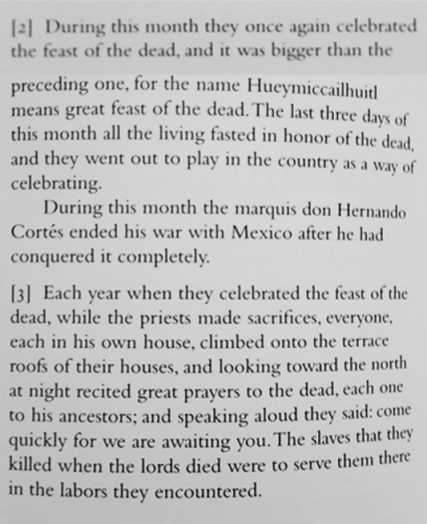Prior to the Spanish invasion, Mesoamerican traditions of honoring the dead were celebrated with two specific feasts: Mikailwitl (feast of the dead), and Wey Mikailwitl (great feast of the dead). These feasts were celebrated in early August through mid-September.
Many think that Mikailwitl and Wey Mikailwitl were absorbed into All Saints Day and All Souls Day under the direction of the Catholic Church, as these two Catholic holidays also involve honoring the dead. This popular claim is often repeated without any evidence to back it up. For example, a recently published column about Dia de Muertos at weareyourvoicemag states “in an attempt to convert the natives to Catholicism, the Spanish colonizers moved the celebration to November 1 and 2 (All Saints Day), which is when we celebrate it currently.”
But is this how it really happened?
The process of combining older rituals into another religion is known as Syncretism, and is intended to help ease religious conversion. While Catholic priests often employed syncretism as a strategy of conversion in the “New World,” this is not what happened in regards to the festivals of Mikailwitl and Wey Mikailwitl.
In fact, it was the exact opposite!
The Codex Telleriano-Remensis describes the feast of Mikailwitl on folio 2r:

The Codex Telleriano-Remensis also describes the feast of Wey Mikailwitl on folio 2v:


The writings of Diego Duran reveal that these Mesoamerican feasts were not moved under the direction of Catholic priests, but were hidden in the feasts of All Saints Day and All Souls Day by the indigenous people themselves. This subversive act of resistance was intended to fool the Catholic priests into thinking the Mesoamericans had, indeed, submitted to Christianity. Here we see Duran’s complaint:

In time, this celebration took on the name “Dia de Muertos.” Personally, I find it inspiring to know that my ancestors used all means of resistance in order to navigate and negotiate their way through the Spanish invasion. Let us honor their memory by continuing this resistance!
Ma Tiakan Timazewalmeh!!
Interested in learning more about Mesoamerican cosmovision? Check out my book “Our Slippery Earth: Nawa Philosophy in the Modern Age” available on Amazon.com. In it, I discuss basic themes of Nawa philosophy, and how these themes can be practiced in the modern age.

Kurly Tlapoyawa is an archaeologist, author, and ethnohistorian. His research focuses primarily on the interaction between Mesoamerica, Western Mexico, and the American Southwest. Kurly has lectured at UNLV, University of Houston, and Yale University on topics related to Mesoamerica. His recent book, “Our Slippery Earth: Nawa Philosophy in the Modern Age” was published in 2017. In addition to his work in Archaeology and Ethnohistory, Kurly is a professional stuntman with over 35 credits to his name.
Follow Kurly on twitter @KurlyTlapoyawa


